
Hilton Hotels & Resorts is a global brand of full-service hotels and resorts and the flagship brand of American multinational hospitality company Hilton.

The LeVeque Tower is a 47-story skyscraper in Downtown Columbus, Ohio. At 555 feet 5 inches (169.29 m) it was the tallest building in the city from its completion in 1927 to 1974, and remains the second-tallest today.

Charles Howard Crane was an American architect who was primarily active in Detroit, Michigan. His designs include Detroit's Fox Theatre and Olympia Stadium, as well as LeVeque Tower in Columbus, Ohio, which remains that city's second tallest building.

The Palace Theatre is a 2,695-seat restored movie palace located at 34 W. Broad Street in Columbus, Ohio. It was designed and built in 1926 by the American architect Thomas W. Lamb as part of the American Insurance Union Citadel. Today the theater functions as a multi-use performing arts venue. It is owned and operated by The Columbus Association for the Performing Arts. The Palace Theater's "house" is considered separate from LeVeque Tower, while the marquee and lobby are part of the LeVeque complex.
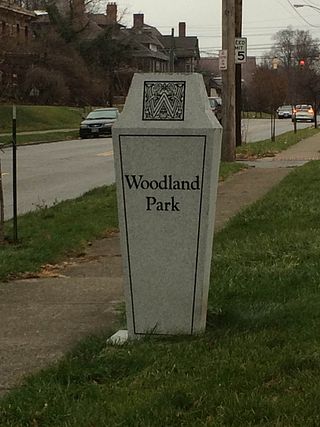
Woodland Park is a residential neighborhood located in the Near East Side of Columbus, Ohio that houses approximately 1,500 residents. The neighborhood was previously home to such figures as artist Emerson Burkhart, cartoonist Billy Ireland, and judge William Brooks. Established in the early 20th century, Woodland Park has grown from its planned neighborhood roots into a neighborhood that contains various faith communities, schools, sources of entertainment and recreation, and borders an extension of the Ohio State University medical center.

Schiller Park is a 23.45-acre (9.49 ha) municipal park located in German Village, a historic neighborhood in Columbus, Ohio. The park is bounded by Reinhard Avenue to the north, Jaeger Street to the east, East Deshler Avenue to the south, and City Park Avenue to the west.
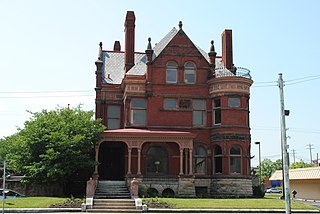
The W. H. Jones Mansion was built in 1889 at 731 East Broad Street, Columbus, Ohio as the residence of dry goods store owner William H. Jones and his wife Josephine. The original cost to build it was $11,250. He lived there until 1923. Jones modelled the house after another mansion in Barnesville, Ohio. The Olde Towne East Neighborhood Association successfully prevented it from being demolished to make way for a Long John Silver's restaurant. The home is an example of Queen Anne style architecture, with a corner turret, third story ballroom and a carriage house in the rear. Its foundation is high ashlar stone, its roof is slate, and the main body of the building is made of red pressed brick.
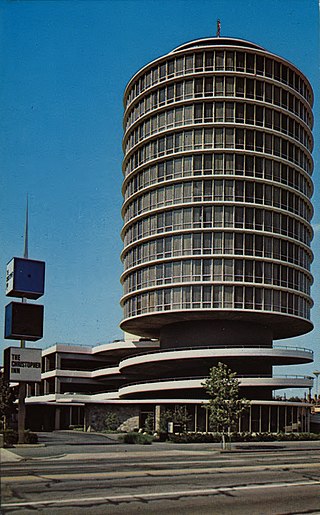
The Christopher Inn was a hotel in Downtown Columbus, Ohio. The cylindrical mid-century modern hotel had 16 floors, 137 wedge-shaped rooms, and modern interiors at the time. It was built on the site of the Alfred Kelley mansion, which was disassembled in order to build the hotel. The Christopher Inn operated from 1963 to 1988, when it was demolished. The site is now occupied by an 11-story office building constructed in 2001.
S.G. Loewendick & Sons, also known as Loewendick Demolition Contractors, is a demolition company based in Grove City, Ohio, a suburb of Columbus. The company is the largest specializing in demolition in Central Ohio. It has torn down most of the landmark buildings in Columbus in recent decades, including Union Station, the Ohio Penitentiary, the Christopher Inn, the Deshler Hotel, and the Ohio State University Drake Performance and Event Center.

Central Market was a public market in Downtown Columbus, Ohio. The market operated from 1814 to 1966, was the location of Columbus's first city hall for two decades, from 1850 to 1872. It moved three times, each time into successively larger buildings. The third market building stood the longest time, from 1850 to 1966, when it was demolished as part of the Market-Mohawk Urban Renewal project. North Market remains, the only one left of four public markets that operated in the city.
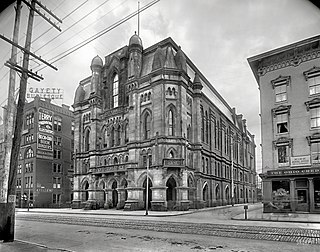
Columbus City Hall was the city hall for Columbus, Ohio, located on Capitol Square in the city's downtown. The building served the mayor and city council from its construction in 1872 until its demolition in 1921. The building was the founding site for the United Mine Workers of America in 1890. In 1928, the site became home to the Ohio Theatre, and the current Columbus City Hall opened nearby.

The Columbus Board of Trade Building was a historic building on Capitol Square in Downtown Columbus, Ohio. The building was built in 1889 for the present-day Columbus Chamber of Commerce, and was designed by Elah Terrell and Joseph W. Yost. It became vacant in 1964 and was demolished five years later. The Rhodes State Office Tower sits on the site today.
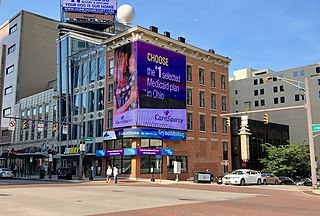
The National Exchange Bank building is a historic building on Capitol Square in Downtown Columbus, Ohio. The building, at 1 W. State St., was constructed in the 1860s as a bank, making it one of the oldest commercial buildings on Capitol Square. Today the building houses a branch of Heartland Bank.

The Hilton Columbus Downtown is a high-rise hotel in Columbus, Ohio. The Hilton hotel includes two buildings, one west of High Street, which opened in 2012, and a new tower east of High Street, which opened in September 2022. The tower addition gives the hotel a total of 1,000 guest rooms, making it the largest hotel in Ohio.
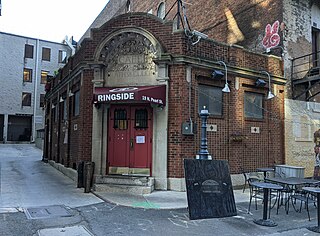
Ringside Café is a restaurant and bar in Downtown Columbus, Ohio. The restaurant is considered the oldest bar or restaurant in Downtown Columbus, having opened in 1897 and operated continuously since then. The restaurant has always been an attraction of politicians, lawyers, reporters, and lobbyists, given its proximity to the Ohio Statehouse, Columbus City Hall, and other government buildings.
Nagy Brothers Shoe Repair is a historic building in the Hungarian Village neighborhood of Columbus, Ohio. The one-story structure was built in 1932 in a vernacular commercial style. The building was historically used as a shoe repair shop and gas station.

The Hartman Building and Theater was a pair of historic buildings on Capitol Square in Downtown Columbus, Ohio. The structures were commissioned by Samuel B. Hartman, designed by Richards, McCarty and Bulford in the Renaissance Revival style. The theater was demolished in 1971, followed by the office building in 1981.
The following is a bibliography of Columbus, Ohio. It includes selected publications specifically about the city of Columbus, Franklin County, and the Columbus metropolitan area.

















